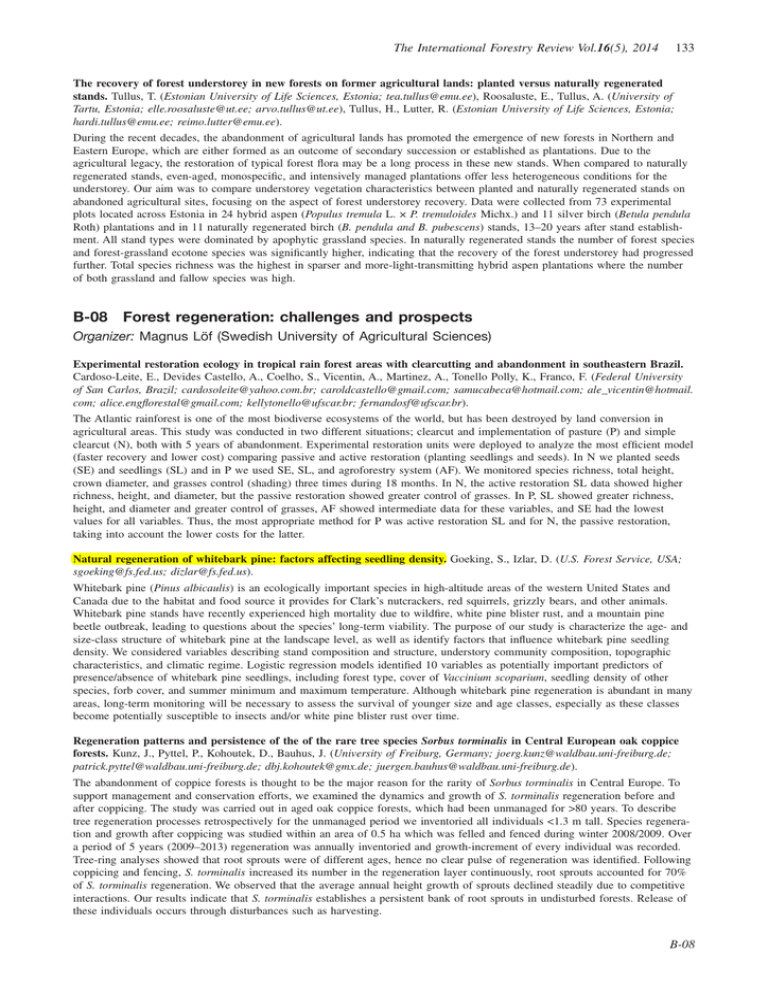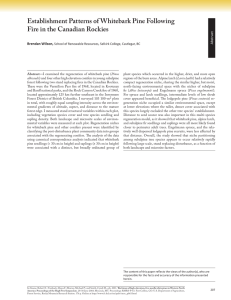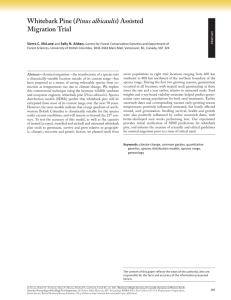Document 12079366
advertisement

The International Forestry Review Vol.16(5), 2014 133 The recovery of forest understorey in new forests on former agricultural lands: planted versus naturally regenerated stands. Tullus, T. (Estonian University of Life Sciences, Estonia; tea.tullus@emu.ee), Roosaluste, E., Tullus, A. (University of Tartu, Estonia; elle.roosaluste@ut.ee; arvo.tullus@ut.ee), Tullus, H., Lutter, R. (Estonian University of Life Sciences, Estonia; hardi.tullus@emu.ee; reimo.lutter@emu.ee). During the recent decades, the abandonment of agricultural lands has promoted the emergence of new forests in Northern and Eastern Europe, which are either formed as an outcome of secondary succession or established as plantations. Due to the agricultural legacy, the restoration of typical forest flora may be a long process in these new stands. When compared to naturally regenerated stands, even-aged, monospecific, and intensively managed plantations offer less heterogeneous conditions for the understorey. Our aim was to compare understorey vegetation characteristics between planted and naturally regenerated stands on abandoned agricultural sites, focusing on the aspect of forest understorey recovery. Data were collected from 73 experimental plots located across Estonia in 24 hybrid aspen (Populus tremula L. × P. tremuloides Michx.) and 11 silver birch (Betula pendula Roth) plantations and in 11 naturally regenerated birch (B. pendula and B. pubescens) stands, 13–20 years after stand establishment. All stand types were dominated by apophytic grassland species. In naturally regenerated stands the number of forest species and forest-grassland ecotone species was significantly higher, indicating that the recovery of the forest understorey had progressed further. Total species richness was the highest in sparser and more-light-transmitting hybrid aspen plantations where the number of both grassland and fallow species was high. B-08 Forest regeneration: challenges and prospects Organizer: Magnus Löf (Swedish University of Agricultural Sciences) Experimental restoration ecology in tropical rain forest areas with clearcutting and abandonment in southeastern Brazil. Cardoso-Leite, E., Devides Castello, A., Coelho, S., Vicentin, A., Martinez, A., Tonello Polly, K., Franco, F. (Federal University of San Carlos, Brazil; cardosoleite@yahoo.com.br; caroldcastello@gmail.com; samucabeca@hotmail.com; ale_vicentin@hotmail. com; alice.engflorestal@gmail.com; kellytonello@ufscar.br; fernandosf@ufscar.br). The Atlantic rainforest is one of the most biodiverse ecosystems of the world, but has been destroyed by land conversion in agricultural areas. This study was conducted in two different situations; clearcut and implementation of pasture (P) and simple clearcut (N), both with 5 years of abandonment. Experimental restoration units were deployed to analyze the most efficient model (faster recovery and lower cost) comparing passive and active restoration (planting seedlings and seeds). In N we planted seeds (SE) and seedlings (SL) and in P we used SE, SL, and agroforestry system (AF). We monitored species richness, total height, crown diameter, and grasses control (shading) three times during 18 months. In N, the active restoration SL data showed higher richness, height, and diameter, but the passive restoration showed greater control of grasses. In P, SL showed greater richness, height, and diameter and greater control of grasses, AF showed intermediate data for these variables, and SE had the lowest values for all variables. Thus, the most appropriate method for P was active restoration SL and for N, the passive restoration, taking into account the lower costs for the latter. Natural regeneration of whitebark pine: factors affecting seedling density. Goeking, S., Izlar, D. (U.S. Forest Service, USA; sgoeking@fs.fed.us; dizlar@fs.fed.us). Whitebark pine (Pinus albicaulis) is an ecologically important species in high-altitude areas of the western United States and Canada due to the habitat and food source it provides for Clark’s nutcrackers, red squirrels, grizzly bears, and other animals. Whitebark pine stands have recently experienced high mortality due to wildfire, white pine blister rust, and a mountain pine beetle outbreak, leading to questions about the species’ long-term viability. The purpose of our study is characterize the age- and size-class structure of whitebark pine at the landscape level, as well as identify factors that influence whitebark pine seedling density. We considered variables describing stand composition and structure, understory community composition, topographic characteristics, and climatic regime. Logistic regression models identified 10 variables as potentially important predictors of presence/absence of whitebark pine seedlings, including forest type, cover of Vaccinium scoparium, seedling density of other species, forb cover, and summer minimum and maximum temperature. Although whitebark pine regeneration is abundant in many areas, long-term monitoring will be necessary to assess the survival of younger size and age classes, especially as these classes become potentially susceptible to insects and/or white pine blister rust over time. Regeneration patterns and persistence of the of the rare tree species Sorbus torminalis in Central European oak coppice forests. Kunz, J., Pyttel, P., Kohoutek, D., Bauhus, J. (University of Freiburg, Germany; joerg.kunz@waldbau.uni-freiburg.de; patrick.pyttel@waldbau.uni-freiburg.de; dbj.kohoutek@gmx.de; juergen.bauhus@waldbau.uni-freiburg.de). The abandonment of coppice forests is thought to be the major reason for the rarity of Sorbus torminalis in Central Europe. To support management and conservation efforts, we examined the dynamics and growth of S. torminalis regeneration before and after coppicing. The study was carried out in aged oak coppice forests, which had been unmanaged for >80 years. To describe tree regeneration processes retrospectively for the unmanaged period we inventoried all individuals <1.3 m tall. Species regeneration and growth after coppicing was studied within an area of 0.5 ha which was felled and fenced during winter 2008/2009. Over a period of 5 years (2009–2013) regeneration was annually inventoried and growth-increment of every individual was recorded. Tree-ring analyses showed that root sprouts were of different ages, hence no clear pulse of regeneration was identified. Following coppicing and fencing, S. torminalis increased its number in the regeneration layer continuously, root sprouts accounted for 70% of S. torminalis regeneration. We observed that the average annual height growth of sprouts declined steadily due to competitive interactions. Our results indicate that S. torminalis establishes a persistent bank of root sprouts in undisturbed forests. Release of these individuals occurs through disturbances such as harvesting. B-08




